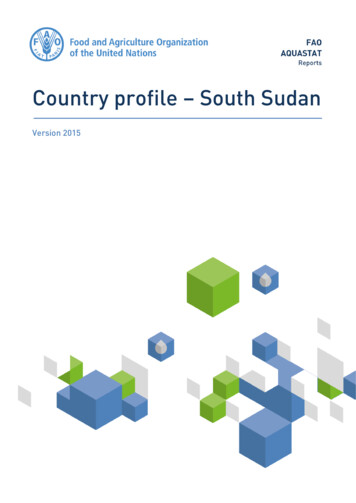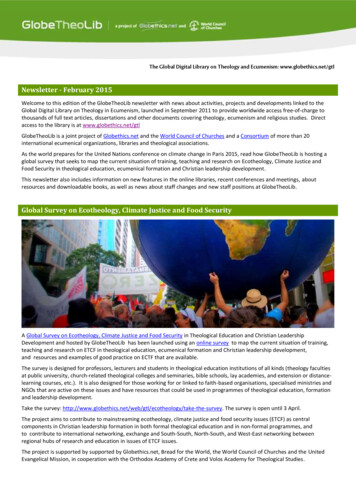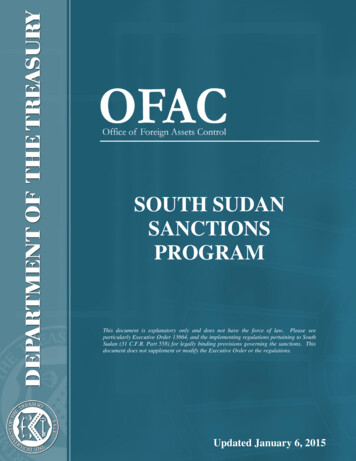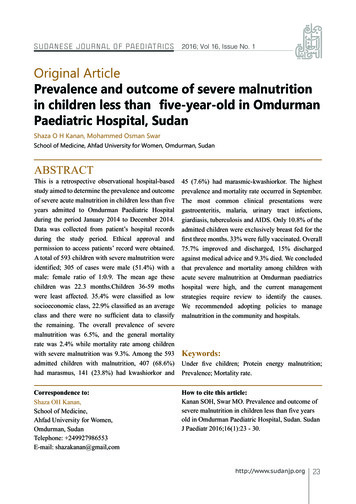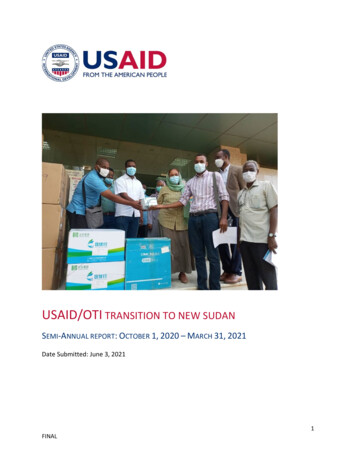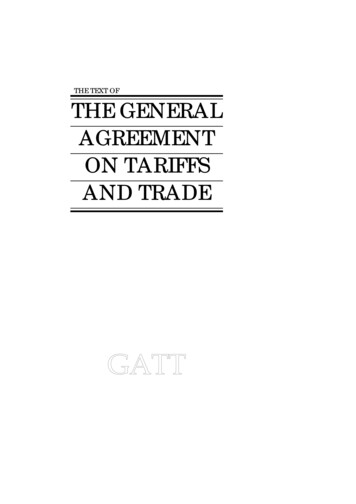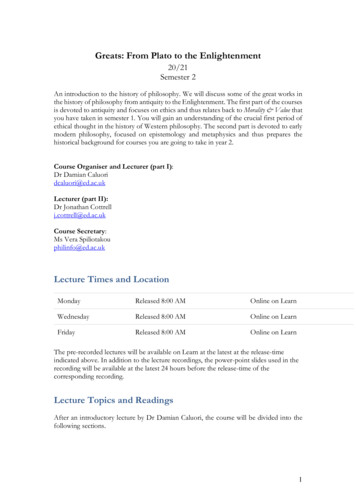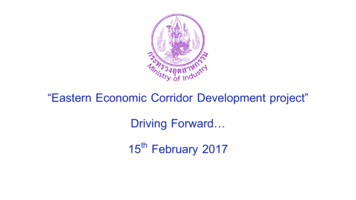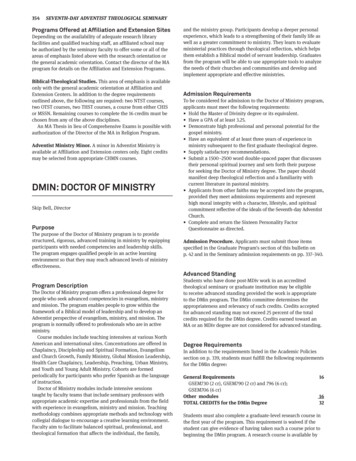
Transcription
REPUBLIC OF SOUTH SUDANMINISTRY OF AGRICULTURE, FORESTRY,COOPERATIVES and RURAL DEVELOPMENTAGRICULTURE SECTOR POLICY FRAMEWORK (ASPF):2012-2017JUBAAUGUST 2012Ministry of Agriculture, Forestry, Cooperatives and Rural Development (MAFC&RD- 2012)Page 1
ForwardByHon Dr Betty Achan OgwaroMinister of Agriculture Forestry Cooperatives and Rural DevelopmentThe economy of South Sudan is based on agriculture, which consists of acombination of subsistence farming, livestock rearing, fishing and wild foodcollection. About 85% of the households cultivate land and around 65% own cattle.About 79% of the total household consumption is spent on food (81% in rural and69% in urban areas). The overall objective of the Republic of South Sudan is toguarantee “food for all” by year 2015. This will require a radical transformation ofthe management of the agricultural sector so as to enhance farm productivity.Cereal production, for example, will have to more than double from the averagelevel of 700,000 mt to 1,500,000 mt per annum.The food deficit in South Sudan can generally be resolved by addressing structuralweaknesses contributing to low agricultural productivity through improvements inthe state of infrastructure; provision of agricultural services; strengthening ofinstitutions and implementing well designed policies and regulations. Otherinterventions will include having in place adequately skilled human resources;rational use of natural resources; having properly organised rural communities; andimproved land use and tenure system.This agricultural sector policy framework (ASPF) for 2012-2017 is formulated withthe goal of increasing production and productivity on a sustainable basis byaddressing key constraints in food and agricultural production, marketing,distribution and value addition. This policy framework, was initially prepared bystakeholders in 2011 as Food and Agricultural Policy Framework (FAPF) for 20112016, and later modified in 2012 as an overarching Agricultural Sector PolicyFramework (ASPF). The framework sets out a broader policy outlook on how thesector should be managed to realise the overall objectives of ensuring food selfsufficiency and agro-industrial development.According to the Economic Development Pillar of the South Sudan DevelopmentPlan, the greatest potential for initial new growth is expected to come from the smallscale private, predominantly family-based, agriculture and livestock sectors. This is inline with the Ministry’s Vision of Food security for all the people of the Republic ofSouth Sudan, and the Ministry’s Mission creating an enabling environment for thetransformation of agriculture from a subsistence system into a modern, socially andeconomically sustainable system through science-based, market-oriented,competitive and profitable farming while maintaining the integrity of the naturalresource base for the benefit of future generations of South Sudanese people.The Agricultural Sector Policy Framework is in line with the objectives of the InterimConstitution of The Republic of South Sudan, 2005, especially article 40, whichrequires all levels of government to develop policies aimed at increasing productionand creating an efficient and self-reliant economy; and, to protect and ensureMinistry of Agriculture, Forestry, Cooperatives and Rural Development, 2012Page2
sustainable management and utilization of Natural Resources. This will largelycontribute to achievement of millennium development goals on eradication ofextreme hunger and poverty for the people of the Republic of South Sudan and theachievement of vision 2040 whose objective, among others, is to have a prosperousand a productive nation through investment in Agriculture to achieve food securityIn order to achieve the goal of a revitalized agriculture that contributes to shared,inclusive and sustainable economic development, the following key issues andobjectives have shaped the Agriculture Sector Policy Framework (ASPF). Theyinclude; acceleration of food and agricultural production while ensuring that thegrowth is pro-poor and sustainable and contribute to food and nutrition securitythrough commercial smallholder and large scale agriculture, using mechanized andirrigation technologies. This will require both local and foreign direct investments inthe sector; Improved agricultural markets and trade though investing in marketinfrastructure and institutions, and developing linked value chains businesses forlocal, regional and international markets; Develop and enhance human andinstitutional capacity, using different entry points from central government tocommunity based organizations (CBOs) and business associations in the context ofdecentralization and empowerment of local communities. The Government willpursue a policy of public-private partnership and promote private sector, whileinvesting in public good such as Research and Development, strategic direction,coordination, oversight, regulation, and monitoring and evaluation; and pursueagricultural growth with social and economic development, whereby the populationhave access to food and are free from poverty.Among the guiding principles include, decentralization of services and communityempowerment; adoption of pluralistic extension approach supported the privatesector and target communities; promotion of Public-Private Partnership in deliveringbasic social services in the sector; promotion of Cooperatives and Farmer groups;value addition and agro-processing; and strengthening of rural infrastructure forroads, electricity and water as well as creating the right policies and environment formarketing and doing business in general.MAFC&RD shall make an effort to involve and work with relevant regionalorganizations and initiatives, such as the Comprehensive Africa AgricultureDevelopment Program (CAADP). There is also an opportunity to take advantage ofglobal funds that encourage forest conservation and minimum emission of carbondioxide in the production processes as part of climate change mitigation measuresand ensuring green economic growth. Locally, the Ministry will continuecollaborating with other line ministries at both the national and state levels.Hon Betty Achan Ogwaro,Minister of Agriculture, Forestry, Cooperatives and Rural DevelopmentMinistry of Agriculture, Forestry, Cooperatives and Rural Development, 2012Page3
Executive SummarySouth Sudan has an immense potential for sustainable agricultural development withabundant land and favourable agro-ecology conditions. More than half of the totalland area is prime agricultural land, while the remaining 50 per cent is composed ofmarginal arable land, forests, mountains, rivers and wetlands. The total land area ofSouth Sudan is about 658,842 sq km while cultivated area is 27,712 sq km. Much ofthe country receives adequate annual rainfall, favourable to grow a range of crops.The amount and distribution of rainfall varies by region ranging from 500 mm peryear in the north, providing a growing season of 100-150 days, to about 2000 mm inthe Southwest where the growing season is 150-250 days. The potential for irrigatedagriculture is huge thanks to many permanent large and small rivers, seasonal rivers,as well as underground water reservoirs. There are also extensive swamplands thatcould be developed for large scale rice and sugarcane production schemes.The diverse soil and climatic conditions provide multiple options to grow differentcrops. Some of the world’s rare and indigenous crop varieties such as finger milletand sorghum are important part of the traditional farming systems. Other cropsinclude cereals such as sorghum, finger millet and maize; root and tubers likecassava, sweet potato and yams; oilseeds like groundnut, sesame, soybean andsunflower; pulses like beans, cowpeas and pigeon pea; fruits such as mangoes,citrus, avocados; and vegetables; and cash crops coffee, tea, cotton and sugarcane.Both the forest and non-timber products are also important in supporting thelivelihoods of the rural population.This Agricultural Sector Policy Framework (ASPF) spells out the Ministry’s policyposition for improved management of the agriculture sector, which is defined toinclude food and non-food crops as well as forestry, Cooperatives and RuralDevelopment. This document deals with various services needed for the sector toyield the intended results for ensuring the Republic of South Sudan has enough foodfor all by year 2015.This framework summarizes various policies that have so far been developed toguide the revitalization of the Agriculture Sector. They include policies on:Agricultural Production and Support Services like Research, Cooperatives, Ruraldevelopment, Access to land, Water and irrigation, Agricultural Inputs, Seedmultiplication, Plant protection and Mechanization; Support of Agricultural Markets,Value Chain Development and Finance; Food Security and Nutrition; ForestryDevelopment and Management; Role of Agriculture and Forestry to Socio EconomicChange; Sustainable Agriculture, Environmental and Climatic Change; GenderMainstreaming; Coordination , Monitoring and Evaluation.The Agricultural Sector Policy Framework forms a basis for development of detailedsector policies to guide this sector in the next five yearsMinistry of Agriculture, Forestry, Cooperatives and Rural Development, 2012Page4
Table of ContentsForward . 2LIST OF ACRONYMS . 71.The Agro-ecology of South Sudan . 92.The Agricultural Sector . 92.1 Opportunities . 102.2 Constraints and Challenges to Agricultural Growth and Development . 122.3 Problem statement . 133.Vision, Mission and Objectives of MAFC&RD . 143.1 Development Pillar . 143.2 Our Vision . 153.3 Our Mission . 153.4 Our Goal . 153.5 Key Policy Choices and Objectives . 154.0Sub-sector Polices. 20Summary of the Sub-sector Policies . 214.1Policies on Crops Sub-Sector . 214.2 Policies on Agricultural Production Support Services . 214.2.1 Extension Services and Agricultural Education Training. 214.2.2 Cooperative Development . 224.2.3 Rural and Community Development . 224.2.4 Agricultural Research . 224.2.5 Plant Genetic Resources Conservation . 234.2.6 Access to Land, Tenure Security and Land Use . 234.2.7 Water Resources Development and Irrigation . 234.2.8 Fertilizer Distribution . 244.2.9 Seed Multiplication, Certification and Distribution . 244.2.10 Plant Protection Using Integrated Pest and Disease . 24Management . 244.2.11 Agricultural Mechanization . 244.3 Policies In Support Of Agricultural Markets, Value Chain Development AndFinance . 254.3.1 Agricultural Markets and Agribusiness . 254.3.2 Rural Financial Services . 254.3.3 Agricultural Insurance Schemes and Early Warning Systems . 264.4 Policies On Food Security And Nutrition . 264.5 Policies On Forestry Development And Management. 264.6 Policies On Role Of Agriculture And Forestry To Economic Change AndSocial Justice . 274.7 Policies On Sustainable Agriculture, Environment And Climate Change . 274.8 Policy On Coordination And Monitoring And Evaluation (M&E) . 284.9 Other Key Policies On The Wider Agricultural Sector . 285.0Policies on Crops Sub-sector . 285.1 Food crops . 285.1.1 Cereals, pulses and oilseeds . 28Establishment of Value Chain Development Programs for Maize and Rice . 305.1.2 Roots and tubers . 305.1.3 Horticultural crops . 30Ministry of Agriculture, Forestry, Cooperatives and Rural Development, 2012Page5
5.2 Cash Crops . 316.0Policies On Agricultural Production Support Services . 326.1 Extension and advisory services . 336.2 Agricultural education and training . 346.3 Cooperatives and Rural Development and Cooperatives . 356.3.1 Cooperative Development . 356.3.2 Rural and Community Development . 376.5 Plant genetic resources conservation . 406.6 Access to land, tenure security and land use . 416.7 Water resources development and irrigation. 436.8 Agricultural production services . 446.8.1 Fertilizer importation, manufacturing and distribution . 446.8.2 Seed multiplication, certification and distribution . 456.8.3 Plant Protection Using Integrated pest and Disease Management . 476.8.4 Agricultural mechanization . 487.0Policies In Support Of Agricultural Markets, Value Chain Developmentand finance. 497.1 Agricultural Markets and Mgribusinesses. 497.2 Rural financial services . 517.3Agricultural Insurance schemes and early warning systems . 528.0Policies On Food Security And Nutrition . 538.1 Food security . 548.2 Nutritional security . 558.3 Bio-Fuels . 569.0Policies On Forestry Development And Management . 5710.0 Policies On Role Of Agriculture And Forestry To Socio-Economic Change . 5910.1Agricultural employment for the female and male youth . 5911.0 Policies On Sustainable Agriculture, Environment And Climate Change . 6011.1 Sustainable Environment and Climate Change. 6011.2 Green Economic Growth . 6112.0 Policies On Social Justice . 6212.1Gender mainstreaming in agriculture . 6212.2Vulnerable groups and agriculture . 6312.2Mainstreaming HIV and AIDS in Agriculture . 6413.0 Policy Coordination and Monitoring And Evaluation (M&E) . 6513.1Coordinating agricultural development with other sectors . 6513.2Coordination of agricultural development between national and statelevel ministries of agriculture and forestry. 6613.3Monitoring and evaluation . 6713.4 Food and agricultural statistics service for monitoring and evaluation . 6914.0 Other Key Policies On The Wider Agricultural Sector . 7015.0 The Implementation of The Policy . 7115.1Institutional Arrangement For Implementing This Policy . 7115.2Financing Of The Strategic Implementation Of The Policy. 71THE IMPLEMENTATION OF THE POLICY. 71Ministry of Agriculture, Forestry, Cooperatives and Rural Development, 2012Page6
LIST OF ACRONYMSAETAgricultural and Education TrainingAFSTAAfrican Seed Trade AssociationAPISAgricultural Policy Implementation StrategyASPFAgriculture Sector Policy FrameworkBRICSBrazil, Russia, India, China and South AfricaCAADP Comprehensive Africa Agricultural Development ProgrammeCBOsCommunity based organizationsCFRCentral Government Forest ReservesCIGCommon Interest GroupCOMESACommon Market for Eastern and Southern AfricaCPAComprehensive Peace AgreementCSOsCivil Society OrganizationsCVMCassava Mosaic VirusEACEastern Africa CommunityEIAEnvironmental Impact AssessmentFAOFood and Agricultural OrganizationFAPISFood and Agricultural Policy Implementation StrategyFAPFFood and Agricultural Policy FrameworkFDIForeign Direct InvestmentFSCFood Security CouncilFTCFarmer Training CenterGMOsGenetically Modified OrganismsICTInformation Communication TechnologyIPCIntegrated Phase ClassificationIPDMIntegrated Pest and Disease ManagementIWRMIntegrated Water Resource ManagementMAFC&RDMinistry of Agriculture, Forestry, Cooperative and RuralDevelopmentMARFMinistry of Animal Resources and FisheriesMDGMillennium Development GoalMWRIMinistry of Water Resources and IrrigationM&EMonitoring & EvaluationNAFSAPNational Food Security Action PlanNAPANational Adaptation Plan of ActionNBHSNational baseline Household SurveyNBSNational Bureau of StatisticsNDOFF National Forest Development FundNGOsNon-Government OrganizationsNPCANew Partnership for African DevelopmentODAOfficial Development AssistanceOPECOrganisation of Petroleum Exporting CountriesPFR(State Government) Provincial Forest ReservesPMSPPlanting Material Supply ProgrammeMinistry of Agriculture, Forestry, Cooperatives and Rural Development, 2012Page7
PPPPublic-Private PartnershipR&DResearch and DevelopmentREDDReducing Emissions, Degradation and DeforestationRSSRepublic of South SudanSSAMC South Sudan Agricultural Mechanization CorporationSSARO South Sudan Agricultural Research organizationSSCRE South Sudan Research CouncilSS-BST South Sudan Board for Seed TestingSSDPSouth Sudan Development PlanSSFCSouth Sudan Forest CorporationSS-SC South Sudan Seed CouncilSSSNSouth Sudan Seed NetworkWFPWorld Food ProgrammeMinistry of Agriculture, Forestry, Cooperatives and Rural Development, 2012Page8
1. The Agro-ecology of South SudanSouth Sudan covers an area of 658,842 Square kilometres within the centre of theSub-Saharan Africa, and lies within the tropical zone between latitude 3.5º and 12ºNorth and longitude 25º to 36º East. South Sudan borders Ethiopia in the East,Kenya, Uganda and the Democratic Republic of Congo in the South and CentralAfrican Republic in the West and North Sudan in the North. Administratively, SouthSudan is sub-divided into ten States; namely, Central Equatoria, Eastern Equatoria,Jonglei, Unity, Upper Nile, Western Equatoria, Lakes, Northern Bahr El Ghazal,Warrap and Western Bahr El Ghazal. Ecologically, South Sudan is divided into sixagro-ecological zones (MAFC&RD 2007): the Greenbelt, Ironstone Plateau, Hills andMountains, Flood Plains, the Nile / Sobat Rivers and the arid and pastoral zone. TheNile and its tributaries flow down from the highlands of Ethiopia, Uganda and CentralAfrican Republic into the low clay basin to form one of the world’s largest wetlands,the Sudd, averaging 30,000 square km but can cover an area of 130,000 square kmdepending on the discharge from the Albert Nile.The rainfall pattern varies according to agro-ecological zones. In the Green belt itranges from 800 mm to 2,000 mm, while in the Arid Zone it may be as low as 300mm per year. Temperatures range from 25 to 40 C. The growing season is generallybetween 100 to 250 days depending on the agro-ecological zone. Most parts of thecountry have two cropping seasons, April-June and July-December, (SSLHP/2006).Potential arable land in South Sudan covers 30%of the total land surface, whilegrazing land covers 40 %, forests 23 % and swamps and open water 7% (Wongo,1984). Natural forests and woodlands cover 23 % of the land surface of SouthSudan. They are rich in valuable species such as mahogany, Acacia senegal, Acaciaseyal (Gum Acacia) Shear Butternut (Vitellaria paradoxa) and Prunus africana. Thereare also plantation forests of Teak and other species. Considerable potential existsfor the expansion of forest plantations of both indigenous and exotic species.Currently, less than five % of the total land area is utilized for crop production (FAO,SIFSIA, 2010).2.The Agricultural SectorThe overall objective of the Republic of South Sudan is to guarantee “food for all” byyear 2015. This will require a radical transformation of the management of theagricultural sector so as to enhance farm productivity. Cereal production, forMinistry of Agriculture, Forestry, Cooperatives and Rural Development, 2012Page9
example, will have to more than double from current average of 700,000 mt to1,5,00,000 mt per annum.The economy of South Sudan is based on agriculture which consists of a combinationof subsistence farming, livestock rearing, fishing, and wild food collection. About 85%of the households cultivate crops and around 65% own cattle. Many of thehouseholds who do not currently cultivate are returnees lacking immediate access toland. Non-farming households in urban areas mainly operate shops and restaurants.About 79 percent of the total household consumption is spent on food (81% in ruraland 69% in urban areas)1.It will essentially require transformation of farm operations which are mostlyundertaken manually, using a small range of rudimentary tools and implements.Despite abundant land resources, manual land preparation has limited cultivatedarea per household to less than 2 feddans and using traditional low yielding seedswith minimum application of fertilisers. Women provide the bulk of the farm labour.Rain-fed mechanized sector is confined mostly to Upper Nile counties, but alsoincludes some relatively small areas in Unity State. Households engaged inmechanized farming cultivate larger areas and sell their products to markets in NorthSudan. Animal traction has been promoted in some states but lack of spare parts andskills to maintain the mould-board ploughs and cultural barriers have hinderedprogress. Irrigated agriculture accounts for less than 5% of the total cultivated area.Given the dominance of agriculture in employment, livelihood and householdconsumption, a broad based economic growth in South Sudan must be based onaccelerating food and agricultural productivity and production.Promotingagricultural and rural development is crucial to pro-poor growth, particularly insituations where the bulk of the population is dependent on farming. Learning fromChina, India and Vietnam, rapid agricultural growth is regarded as the precursor tothe rise of industry and services. Agriculture-led growth induces strong growth inservice sectors such as transport, processing, finance and trade through multipliereffects. Within the context of South Sudan, agricultural GDP growth is certainly twiceor more as effective as in reducing poverty as GDP growth originating from outsideagriculture. Agricultural growth based on productivity improvement is also anecessary condition for food security.2.1OpportunitiesThe national, regional and international markets provide considerable opportunitiesfor South Sudanese farmers. A large volume of the agricultural produce and productssold in urban areas are currently imported from Uganda, Kenya and Sudan. Giventhe opportunity to develop and improve productivity, food and agriculturalproducers and processors of South Sudan can capture not only local markets but alsoregional markets. With rapidly expanding demand in the Middle East, Asia (e.g.1National Baseline Household Survey (NBHS) 2009; and FAO/WFP Crop and Food SecurityAssessment Mission Jan-2011.Ministry of Agriculture, Forestry, Cooperatives and Rural Development, 2012Page10
China and India), South Sudan has the natural resource potentials to supply food andagricultural products to international markets as well.Peaceful transition and favourable macro-economic environments are among themajor opportunities for successful agricultural development in South Sudan. Nowbeing an independence country, the macro-economic environment for agriculturaldevelopment has become favourable. The SPLM, which is the main ruling party inSouth Sudan, critically reviewed agriculture in 2010 and renewed its commitment toimprove the sectors of agriculture, forestry, livestock and fisheries in order toachieve food security through transforming the subsistence agriculture system to asurplus production system well connected to markets and guarantee householdsaccess to food. The ruling party has also agreed to immediate allocation of at least10% of the oil revenue for agriculture, forestry, fisheries and livestock development.In line with the SPLM’s vision, the Government of the Republic of South Sudan (RSS)is committed to the “establish an effective, democratic, participatory andaccountable government that will empower civil society to become productive andthe driving force in development”. Following such political will, the Ministry ofAgriculture Forestry, Cooperatives and Rural Development (MAFC&RD) shall focus tocreate an enabling and facilitating environment to rehabilitate, stabilize, andtransform South Sudanese agriculture. The global scenario with escalating foodprices should be taken as an opportunity to reap the benefits from a “hungry world”given that the country has ample arable land for crop and livestock production.Goodwill and support of many bilateral and international donors as well as regionaland continental cooperation and initiatives have allowed the RSS to consolidate thepeace and stabilize the region for sustainable agricultural development and growth.Working in partnership with donors and other development partners, the MAFC&RDhas implemented a number of projects aimed at building institutions, developinghuman capacity, and improving food security. The Republic of South Sudan (RSS) isalso consolidating its relationship with neighbouring countries and other Africancountries.MAFC&RD shall make an effort to involve and work with relevant regionalorganizations and initiatives, including the East African Community (EAC) and theCommon Market for Eastern and Southern Africa (COMESA), the ComprehensiveAfrica Agriculture Development Program (CAADP) of the African Union and the NewPartnership for Africa’s Development (NEPAD) or the NEPAD Coordinating andPlanning Agency (NCPA). In particular, CAADP’s goal of eliminating hunger andreducing poverty by improving agriculture across the African continent is consistentwith the goals of MAFC&RD. MAFC&RD’s agricultural policy and strategy willincorporate the four pillars of CAADP, namely (i) Land and water management; (ii)Market access; (iii) Food supply and hunger; and (iv) Agricultural research) designedto improve agricultural productivity and growth. There is also an opportunity to takeadvantage o
line with the Ministry's Vision of Food security for all the people of the Republic of South Sudan, and the Ministry's Mission creating an enabling environment for the transformation of agriculture from a subsistence system into a modern, socially and economically sustainable system through science-based, market-oriented,
